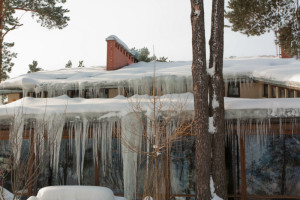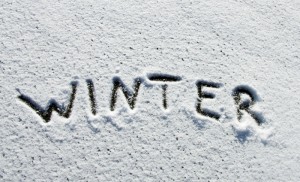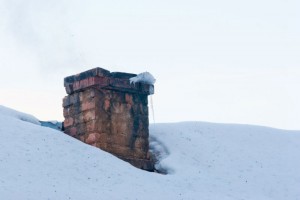by Billy Sweet | Nov 28, 2015 | Freeze Thaw Cycle
You’re likely familiar with the damage the freeze-thaw cycle can do to the roadways; it’s what causes pot holes to appear each year! Water makes its way into the tiny cracks in concrete, asphalt, or stone. When the temperature drops, that water freezes and expands, causing the concrete, asphalt, or stone to crack or crumble. If you have a home with a masonry chimney, you should be aware that the freeze-thaw cycle can cause the same damage to your chimney’s bricks, concrete, and mortar.

Water damage and your chimney
Water can cause many problems with your chimney. The freeze-thaw cycle can cause the mortar between your chimney to crumble; it can cause parts of your brick to flake off, which is referred to as spalling; and it can cause your chimney crown to crack and crumble. Over time, if water damage goes unaddressed, it can mean major problems for your chimney. Your chimney’s overall structure can fail, causing it to lean and become unsafe. A damaged chimney also will let water into the rest of your home, leading to water stains on your ceiling and walls, rotting wood on adjacent structures, collapsed hearth support, a damaged firebox, rusted fireplace accessories, and failing hearth structure.
Repairing water damage
The first step in repairing water damage is to find that damage. This is one reason your annual chimney inspection is so important. Your certified chimney technician can find signs of damage early, so that it can be repaired before minor water damage becomes major water damage. In many cases, it will take the work of expert masons, like those at Billy Sweet Chimney Sweep to repair your chimney’s water damage. We provide services such as tuckpointing, chimney crown repair and replacement, and removing and replacing spalling bricks.
Preventing water damage
When it comes to water damage and your chimney, an ounce of prevention is worth a pound of cure! Taking steps to prevent chimney damage now can save you from costly repairs later. Having a chimney cap installed atop your flue can help keep water from running down the interior walls of your chimney. Repairing a damaged chimney crown will keep water from running down the exterior sides of your chimney. It’s important to make sure the flashing around your chimney is secure, and if your chimney is located on a part of your roof that experiences a lot of rainwater or snow, a cricket — a tent-shaped piece of metal — can be installed to divert water away from the chimney. There also are waterproofing sealants that can be applied to your chimney. Those sealants keep water from seeping into your chimney’s masonry while still allowing your chimney to expel the gases created by your fires.
Ultimately, the key to protecting your chimney from water damage is working with your certified chimney sweep to make sure that any problems are caught and addressed early before you have major chimney damage. If you’re overdue for an inspection, or if you’ve noticed cracking masonry on your chimney, call the experts at Billy Sweet today. We also can talk to you about waterproofing applications to protect your chimney.
by Billy Sweet | Jan 6, 2015 | Winter Chimney
Around this time of year, the chimney often goes unnoticed. With everyone headed inside the escape the chilly winter weather, the chimney is left in the cold to fend for itself. While the robust brick structure may seem able to withstand any weather, masonry chimneys can actually suffer irreparable damage during the winter months. Fortunately, there are some measures that can be taken now to prevent more damage in the future.

Masonry chimneys are chimneys constructed using masonry materials, which include brick, mortar, concrete and stone. All of these materials, aside from stone, have a very porous nature, which means they easily absorb any water that touches them. Similar in function to a sponge, the bricks and other materials can soak up moisture until they reach complete saturations. While the absorption of water does little damage by itself, the trouble begins when the temperature drops below freezing. In sub-freezing temperatures, water begins a freeze and thaw cycle in which it continuously expands and contracts as it freezes and melts, respectively. When the water inside the masonry materials starts this cycle, the materials also experience that same shrinking and swelling movement. Over time, this motion degrades the strength of the materials. The first signs of a weakened chimney include cracked mortar or missing bricks, but eventually the entire structure could fall. To prevent this, a chimney specialist can patch the mortar by tuckpointing and apply a certain permeable sealant to the outside of the chimney to prevent water from entering the structure.
The other winter problem that occurs with the chimney also revolves around water damage. The warmth of the chimney can melt snow and ice at the top of the chimney, permitting water to leak inside. If the flue lining is made of metal, the water can rust out the lining, leading to cracks and holes. This break in the lining exposes the combustibles in the house to the heat of the fire, and it allows the toxic fumes to leak back into the home. Potential hazards of this include house fires and carbon monoxide poisoning. In addition, the water can rust out the damper, which may prevent proper ventilation of the fumes. Water damage may encroach further, as well, which would be evident by the presence of water stains on the walls and ceiling surrounding the fireplace. A chimney specialist can stop this damage from happening by repairing or replacing the chimney crown, if one is present, and installing a proper chimney cap to stop water from entering the chimney.
Prevention is key to avoiding these costly damages, so take the extra time to ask your chimney sweep or inspector about protecting your masonry chimney. For a professional consultation in the Boston or Portland areas, contact Billy Sweet Chimney Sweep.
by Billy Sweet | Sep 15, 2014 | Chimney Maintenance
Your beautiful fireplace has always come through for you. It faithfully heats your home during brutal New England winters and creates a tranquil setting on a snowy evening. Even during the summer, the fireplace acts as a majestic focal point in your home. In fact, the fireplace may be credited with helping to convince you to purchase the home in the first place.

If you want to enjoy your fireplace for years to come, it will need proper maintenance. Most people have the chimney swept every year, which is a good practice but often not enough. The majority of homeowners neglect one piece of chimney care that might result in thousands of dollars in damage: winter effects.
With a masonry chimney, the exterior construction will consist of any material such as brick, stone, mortar or concrete. Additionally, the internal materials may include steel, cast iron or flue tile. Your chimney has some combination of these and each one, except stone, can experience damage after years of exposure to cold, snowy winters.
Brick, mortar and concrete are all very porous materials and will readily absorb water, which includes melted snow as well. When these waterlogged materials go through the freeze and thaw cycle of winter, they also undergo needless distress. This stress inevitably expands and weakens the structure, which leads to cracks or even collapse. While stone is immune to the freeze and thaw stress, if your chimney is made of stone, you still need to watch for water damage. The mortar securing the stones experiences the damages of freezing and needs inspection and repairs even if the stone is unharmed.
The melted snow can also leak inside the chimney, where the steel flue will rust. Now, water can infiltrate the inside of the masonry, which means further damage. If the water travels down the chimney, the damper apparatus eventually rusts, so the fireplace may fail to vent properly. The water may go on to cause more damage such as rusted fireplace face and doors, deteriorated hearth, and soaked ceilings or walls around the fireplace.
The cost of preventing these damages is much more reasonable than paying for the repairs. To properly prevent water damage from melted snow, you have a few options.
Water will first enter the chimney through the top. Having a chimney service install a chimney cap is a great, inexpensive way to prevent interior water damage. Some masonry chimneys also have a structure known as a crown. This concrete slab acts as a roof for the chimney to prevent water from leaking inside. Over time, the concrete will crack, so the crown may require patching or complete replacement to ensure proper water resistance. Another part of the chimney that may leak is the flashing, or the aluminum cover that seals the seam where the chimney protrudes through the roof. The flashing is sealed with tar, which may simply need to be redone. A good way to protect the outside of the chimney is to have a chimney service apply a sealant. The vapor-permeable sealant allows moisture to escape but prevent exterior water from entering the porous materials.
If you live in the areas of Boston, Massachusetts; Portland, Maine, or North Shore, contact Billy Sweet Chimney Sweep for a professional consultation. These experts will ensure your chimney and fireplace will hold up for many more winters to come.
by Billy Sweet | Jul 15, 2014 | Chimney Maintenance

Water should’t be allowed to seep inside your chimney. Many chimney-related problems start with water intrusion.
A lot of what we do for our clients at Billy Sweet Chimney Sweep roots in prevention. We sweep your chimney regularly to prevent excess creosote build-up and potential fire hazards. We install chimney caps to prevent rain and snow from diving right into your flue opening. We apply waterproofing sealant to your masonry to prevent excess moisture intrusion and moisture damage. We inspect your chimney system every year in part to prevent lots of things: draft issues, water or carbon monoxide leaks, even just to prevent small problems from becoming larger, more troubling and more expensive problems.
If it seems like a big part of our preventative efforts are focused on fighting water, you’re right, and there’s good reason for that. Left unchecked, moisture intrusion can cause extensive damage to your chimney system and the exterior and interior building materials around them.
Want a deeper look into how much trouble water can be? Here are three ways water can ruin (or at least significantly damage) your chimney:
“The Freeze/Thaw Cycle”
We all know that water expands when it freezes — you only have to forget you put a glass bottle of soda or beer in the freezer once to brand that messy lesson into your mind. Let’s think about how that can pertain to a chimney. Over years of being exposed to the elements, your masonry can develop some small cracks, whether that’s in your mortar joints or chimney crown, or in your bricks themselves. Moisture can make its way into those small cracks and sit there as the temperature drops. Once it reaches freezing temperatures, that water freezes and expands, straining against the masonry material — and more often than not, the ice wins, causing your masonry to crack, flake and crumble (called spalling). Over time, that can leave you with enough damage to need your whole chimney crown rebuilt, or extensive repairs on your chimney stack.
To avoid extensive spalling and other damage related to the freeze/thaw cycle, Billy Sweet Chimney Sweep technicians aim to repair all cracks and imperfections while they’re still small, whether that means applying a crown coat seal to your chimney crown or tuck pointing your damaged mortar joints. It’s one of the many benefits of keeping up with your annual chimney inspections — we’ll be able to keep on top of issues before they turn into huge hassles.
Corrosion And Rust
We know what happens when metal and moisture collide, too: dark red rust and crumbly corrosion. Since several components in your chimney system are made of metal, rust and corrosion are a concern too. If, say, your chimney cap is missing and moisture is making its way into your flue, it might repeatedly soak your metal throat damper — the part that lets you open and close your flue when you are or aren’t using your fireplace. A rusted throat damper can get stuck, or its plate can corrode and break. Rusted chimney flashing or chase covers can allow moisture to damage the interior of your chimney and your home too.
Chimney inspections are another important part of preventing this kind of damage. But beyond that, we also recommend that clients with galvanized metal components look at replacements made with more durable materials — like stainless steel and copper — which won’t have that kind of vulnerability to rust and corrosion.
Chimney Mold
Mold growth doesn’t really “ruin” your chimney, but it’s absolutely a problem you need to be aware of, since exposure to mold is linked to a variety of health issues, from respiratory problems and allergic reactions and triggering asthma episodes. Mold feeds on moisture, so if a leak develops in your chimney, mold can get a chance to grow and proliferate. Mold remediation is a two-pronged process: We need to get rid of the mold, and we need to repair the leak that was feeding the mold. Billy Sweet technicians are trained in the safe and proper removal of mold, and we can also find and repair any damage that’s leading to leaks. We can also talk with you about some preventative measures that can help you avoid leaks, like chimney waterproofing.
If you have any concerns or questions about water and its relationship with your chimney, we’re always here to help. Give Billy Sweet Chimney Sweep a call!
by Billy Sweet | Mar 5, 2014 | Chimney Maintenance
When the weather warms up, we tend to put our fireplaces and chimney systems out of mind. But before you shut your flue for the season, figuratively and literally, it’s beneficial to consider some spring chimney services that’ll help your chimney come back around to the cold months in the best shape possible.

It’s Springtime! Time to enjoy warm sunny days and let your chimney rest after enduring those cold grueling months of hard labor. Give it some spring chimney care.
So here’s something of a Spring Chimney Care Checklist to go over as your thoughts turn to T-shirts and garden blooms:
Spring Chimney Care Checklist From Billy Sweet Chimney Sweep
Ensure A Clean Chimney And A Non-stinky Spring
If you used your wood-burning fireplace all fall and winter, you doubtlessly have creosote built up in your flue. That’s just part of the equation with burning wood: You get heat, light and creosote. Some folks figure it’s best to just wait until next winter to get the chimney swept, since they’re less concerned about safety and fire hazards when not using the fireplace. But we can make some pretty strong arguments for the benefits of making a chimney sweeping appointment part of your spring chimney care checklist.
First, you’re getting that work done before the busy season, so you’ll have more options in terms of scheduling an appointment with Billy Sweet Chimney Sweep technicians, and most likely a faster turnaround time, too.
More than that, though, you’ll be improving the air in your home all spring and summer. Creosote build-up is one of the most common contributors to a stinky chimney. Creosote has a strong musty smell, and as the temperature and humidity rises, that smell can get stronger. So a spring-cleaned chimney, beyond being ready for winter ahead of time, makes your spring and summer that much more pleasant.
Check For Roof-related Damage
We all know that winter weather can take a toll on our roof, as well as the flashing where the chimney meets the roofline. Before we get into spring rains, it’s good to be aware of any flashing damage, since even something as small as caulking coming off can lead to a chimney leak.
Make Sure Animals Haven’t Moved In, And That They Won’t Be Able To
Some animals — including federally protected chimney swifts — are known for nesting in chimneys during the off-season. And when animals nest in your chimney, they bring along sounds, smells and debris that you certainly don’t want there. Inspecting your flue for nesting animals or signs of nesting animals is a smart thing to do. Preventing nesting animals, by having a quality chimney cap installed, is an even smarter thing to do.
Prep Your Masonry For Moisture
Moisture is, was and always will be the worst friend your chimney has. And during the wetter months, moisture gets a chance to give besting your chimney system’s defenses its all. There’s a lot you can do, though, to protect your system against moisture intrusion, including having Billy Sweet Chimney Sweep inspect your chimney crown and your flashing and having us apply a strong waterproofing sealant to protect your masonry.
You Can Get Through This Spring Chimney Checklist With Billy Sweet’s Help
You can get all of this spring chimney care accomplished — and more — by scheduling a chimney inspection and chimney sweeping appointment with Billy Sweet Chimney Sweep. During an inspection, we’ll check the system bottom to top and let you know if any problems are preventing your chimney from being protected and prepared for the next heating season. Just give us a call to schedule an appointment!





